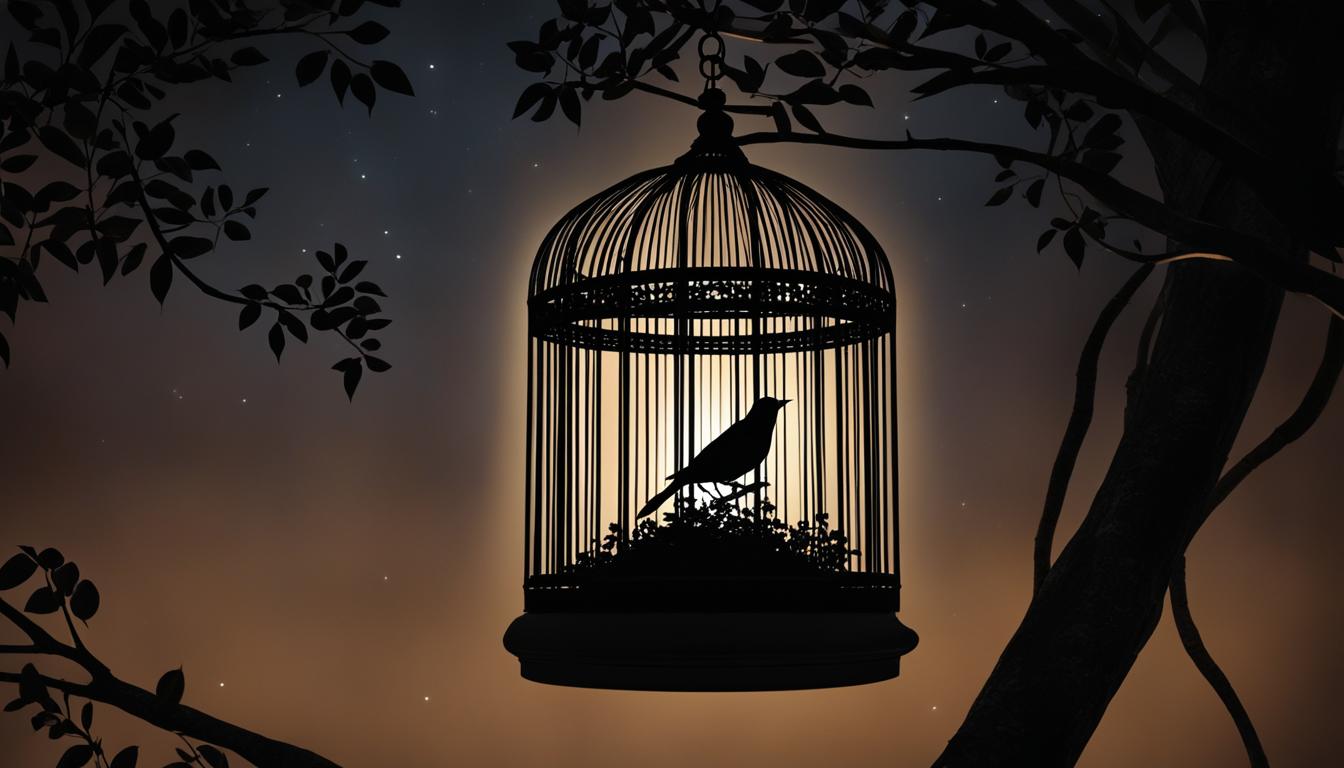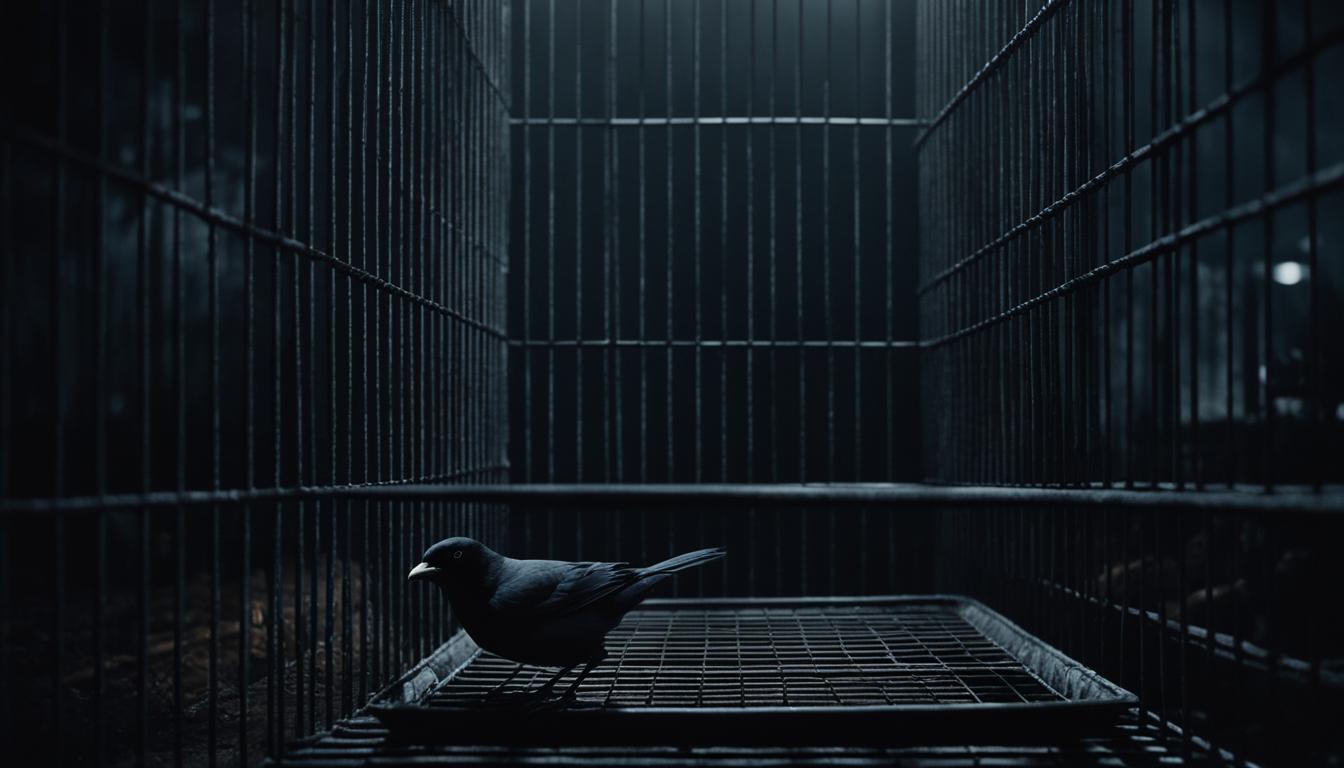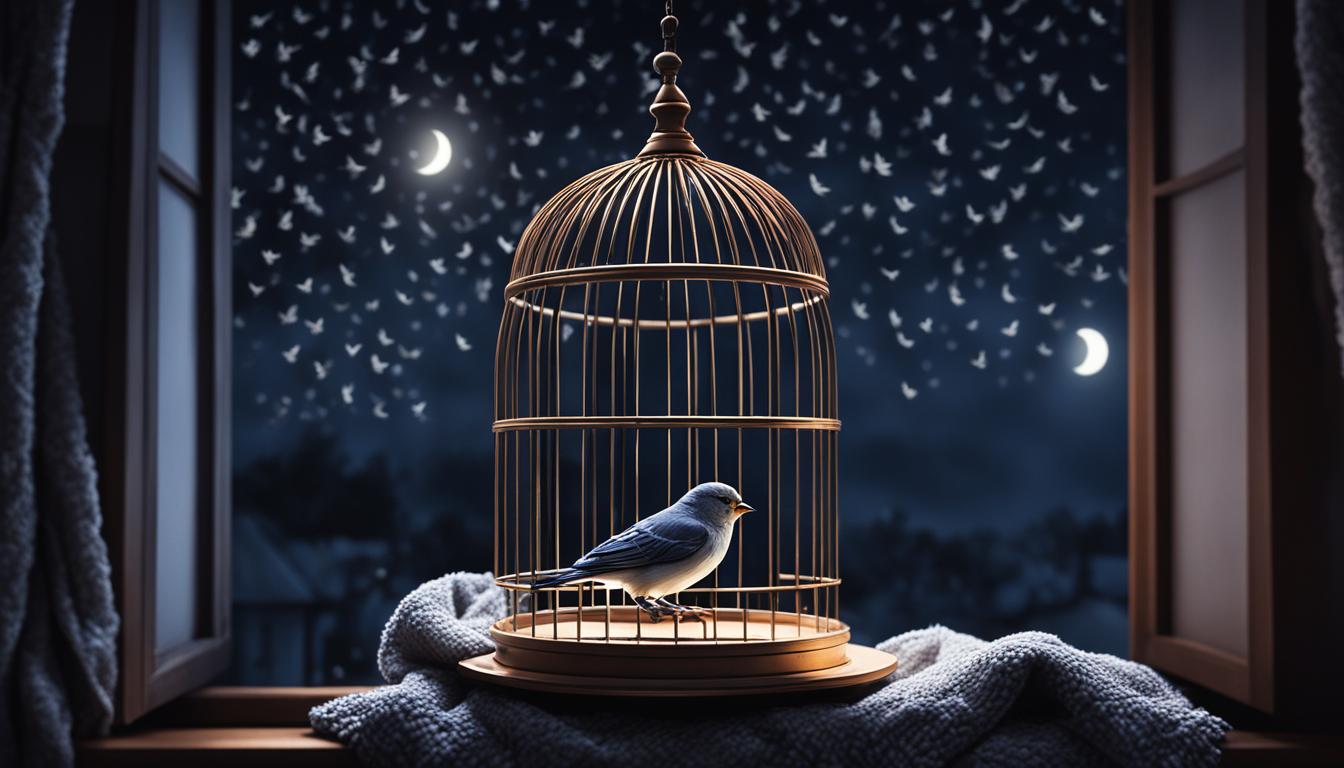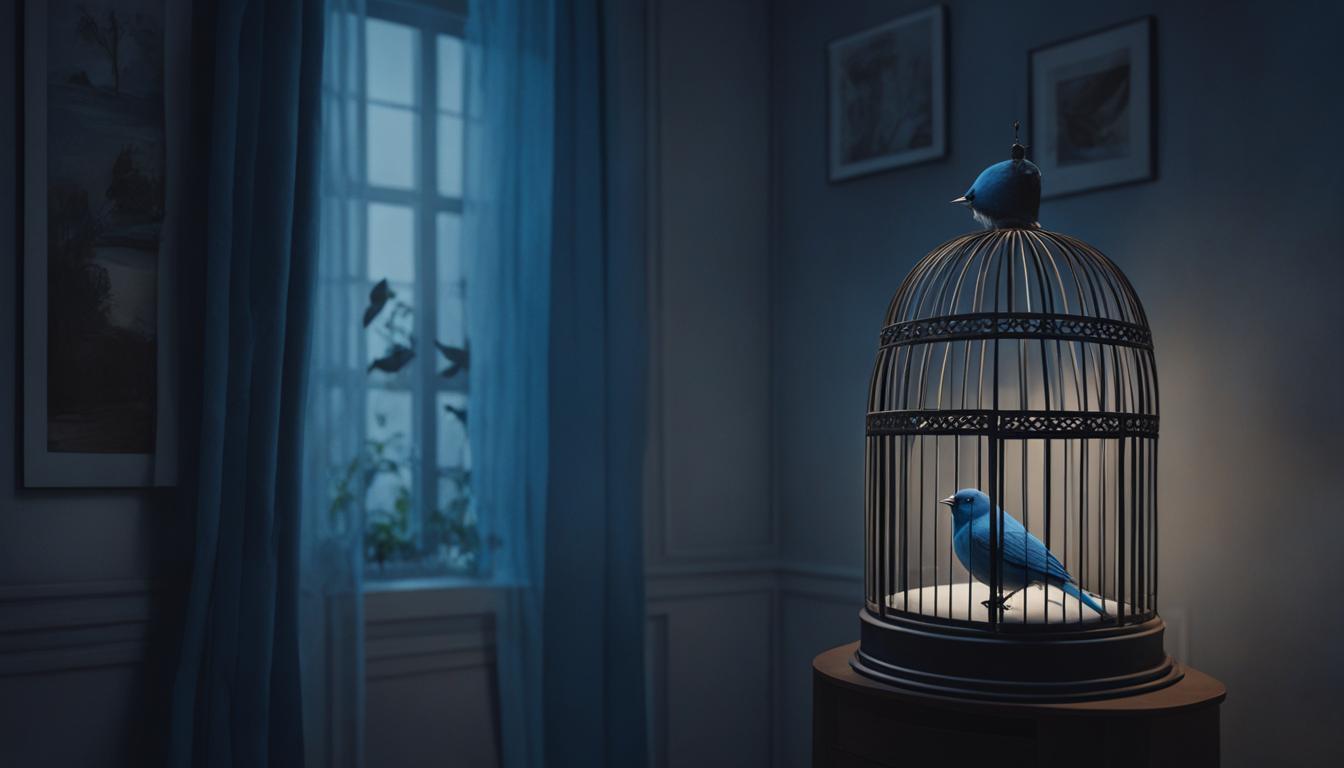If you have a pet bird, you know how important it is for them to get a good night’s sleep. Just like humans, birds need quality rest to stay healthy and happy. One way to ensure that your feathered friend gets the rest they need is by covering their cage at night.
Covering your bird at night with a bird cage cover can provide numerous benefits. It mimics the dark, protected environment of a nest cavity, which is where birds naturally seek to sleep in the wild. By creating this cozy atmosphere, you can help promote better sleep for your bird.
When you cover your bird’s cage at night, you reduce noise, light, and drafts that can disturb their sleep. Birds are sensitive creatures, and even small disruptions can disrupt their sleep patterns. A bird cage cover can create a calm and quiet space where they can rest undisturbed.
Additionally, covering your bird’s cage can help prevent night frights. Night frights, also known as sudden nocturnal panic, are a common condition in birds. They can be triggered by unexpected noises or movements. By providing a dark and secure sleeping environment, you can help minimize the risk of night frights and ensure a restful night for your bird.
So, if you want to ensure that your bird gets the sleep they need, consider covering their cage at night. It’s a simple, yet effective way to create a safe and cozy sleep environment. Check out our upcoming sections to learn more about the factors to consider when choosing a bird cage cover and the potential problems and alternatives to keep in mind.
Do Birds Naturally Seek Dark Sleeping Environments?
In the wild, birds naturally seek out dark sleeping environments, such as nest cavities, to rest and protect themselves. These nest cavities offer a safe and secure space where birds can sleep, raise their young, and feel sheltered from predators and external disturbances.
By covering your bird’s cage at night, you can recreate this dark and protected environment, providing your feathered friend with a sense of security and promoting better sleep. Mimicking the natural sleeping conditions of birds can have a positive impact on their overall well-being.
“Birds sleep in nest cavities, which provide darkness, protection, and a safe place to rest and raise young.”
When birds are surrounded by darkness, they feel more at ease and can relax, knowing that they are tucked away in a secure spot. This helps them achieve the uninterrupted sleep they need to recharge and rejuvenate for the next day.
In addition to recreating a nest cavity-like environment, covering the bird’s cage at night can also reduce the impact of external factors that may disrupt their sleep. This includes minimizing the amount of light, noise, and drafts that could disturb their restful slumber.
By providing a dark and protected sleeping environment, you are ensuring that your bird has the best conditions for a good night’s sleep, helping them maintain their overall health and well-being.
Creating a dark and protected sleep environment for your bird mimics their natural habitat and promotes a sense of security, ultimately leading to improved sleep quality and overall happiness.
Factors to Consider When Covering Your Bird’s Cage at Night
When it comes to covering your bird’s cage at night, there are several factors you should consider to ensure their comfort and well-being. By taking into account your bird’s reactions and the potential effects of noise, light, drafts, and night frights, you can create a sleeping environment that promotes better sleep and a sense of security for your feathered friend.
Noise and Light Reduction
One of the primary benefits of covering your bird’s cage at night is the reduction of ambient noise and light. Birds are sensitive to their surroundings, and excessive noise or light can disrupt their sleep patterns. By covering the cage, you can create a quieter and darker environment, mimicking the conditions of a nest cavity where birds naturally seek sleep.
Protecting your bird from noise and light disturbances during the night helps promote a more peaceful and restful sleep.
Draft Prevention
In addition to reducing noise and light, covering the bird’s cage can also help prevent drafts. Drafts can make your bird uncomfortable and lead to health issues, such as respiratory problems. By providing a barrier between the cage and any drafts, such as from air conditioning or open windows, you can create a cozy and draft-free sleeping space for your bird.
Prevention of Night Frights
Night frights are a common condition in birds, where they become startled and exhibit distressing behaviors during the night. Covering the cage can help prevent these night frights by creating a sense of security and limiting external stimuli that may trigger fear or anxiety in your bird.
By considering your bird’s reactions and implementing appropriate measures to reduce noise, light, drafts, and the occurrence of night frights, you can create a comfortable and peaceful sleeping environment for your feathered companion.

Factors to Consider When Covering Your Bird’s Cage at Night
| Factors | Considerations |
|---|---|
| Noise Reduction | Ensure a quieter sleeping environment for your bird by covering the cage. |
| Light Reduction | Create a darker space that mimics the conditions of a nest cavity. |
| Draft Prevention | Protect your bird from cold drafts for their comfort and health. |
| Prevention of Night Frights | Create a sense of security and limit external stimuli that may startle your bird. |
Potential Problems with Using Cage Covers
While cage covers can be beneficial for creating a sleep-friendly environment for your bird, there are potential problems that can arise from their misuse. It’s important to understand these issues to ensure the well-being and safety of your feathered friend.
Misuse of Cage Covers
Using cage covers as a form of punishment or to mitigate excessive noise can have negative psychological effects on your bird. Covering the cage as a means of discipline can create fear and anxiety, leading to behavioral problems. Additionally, using cage covers to mask noise without addressing the underlying cause can be mean to your bird and hinder training efforts.
Hormonal Changes
Another potential concern with using cage covers is the triggering of hormonal behaviors in birds. The darkness and seclusion created by the cover may mimic the conditions for breeding, making the bird territorial and defensive. This hormonal change can impact their overall behavior and interaction with their environment.
Sleep Quality
Although cage covers aim to promote better sleep, it’s essential to note that not all birds may actually sleep under the cover. Some birds may prefer to perch on top of it or stay awake throughout the night. This can lead to compromised sleep quality, as they are not fully benefiting from the dark and quiet environment that the cover is intended to provide.
Safety Concerns
Using cage covers without considering safety precautions can pose risks to your bird. Potential safety concerns include ingestion of fabric, which can obstruct their digestive system, as well as entanglement in loose threads or cords. Additionally, covering the cage without ensuring proper airflow can limit fresh air circulation and potentially affect your bird’s respiratory health.
To avoid these issues, it’s crucial to use cage covers responsibly and with your bird’s well-being in mind. Constant monitoring and assessment of their reactions to the cover can help determine if it is positively or negatively affecting their sleep and overall behavior.

| Potential Problems | Description |
|---|---|
| Misuse of cage covers | Using covers as punishment or for excessive noise can create psychological problems and negatively affect the bird. |
| Hormonal changes | Cage covers can trigger hormonal behaviors, making the bird territorial and defensive. |
| Sleep quality | Some birds may not actually sleep under the cover, leading to poor sleep quality. |
| Safety concerns | Ingestion of fabric, entanglement, and lack of fresh airflow are safety concerns associated with cage covers. |
Alternatives to Cage Covers for a Good Night’s Sleep
If you’re looking for alternatives to cage covers to ensure a good night’s sleep for your bird, there are a few options you can consider. These alternatives provide a sleep-friendly environment and can help establish a routine for your feathered friend.
Sleeper Cage
A sleeper cage is a great alternative to cage covers. It provides a dedicated space for your bird to sleep in a quiet and dark room. The sleeper cage mimics the natural sleep environment of birds, promoting better sleep and reducing disturbances. Make sure the sleeper cage is comfortable and spacious enough for your bird to move around.
Blackout Curtains
Installing blackout curtains in your bird’s room can create a dark and peaceful sleep environment. These curtains block out external light sources, ensuring a conducive atmosphere for your bird’s rest. Choose curtains that fit the window properly and effectively block light.
Timed Lights
Using timed lights can help establish a sleep routine for your bird. Set the lights to gradually dim down in the evening, providing a signal that it’s time for sleep. This can help regulate your bird’s internal clock and promote a more restful sleep.
By opting for these alternatives, you can create a sleep-friendly environment for your bird, even without using cage covers. Choose the option that suits your bird’s needs and preferences and observe how it positively impacts their sleep quality.

Matching the Cover Material to Your Bird’s Needs
When it comes to choosing the right cage cover for your bird, several factors need to be considered to ensure their comfort and well-being. From the lightness of the fabric to the warmth of the material, these considerations play a vital role in creating an optimal sleep environment for your feathered friend.
Light Fabric for Proper Airflow
Opting for a cage cover made from a light fabric is essential to allow proper airflow within the cage. This promotes ventilation and prevents the accumulation of heat or stuffiness that can disrupt your bird’s sleep. The right balance of airflow ensures a comfortable and refreshing sleep experience.
Warm Material for Colder Weather
In colder weather conditions, it is crucial to provide your bird with a cage cover that offers insulation and warmth. Choose a material that is thicker and provides better heat retention to keep your bird cozy during chilly nights. This helps maintain a comfortable sleeping temperature and prevents potential health issues caused by cold drafts.
The Right Size to Reduce Noise
Ensuring the cover is the right size for the cage is important for noise reduction. A properly fitted cover minimizes the movement of the fabric, effectively reducing any rustling or flapping noises that could disturb your bird’s sleep. Additionally, make sure the cover fully covers the base of the cage to create a quieter and more peaceful sleeping environment.
Regular Washing for Cleanliness
Maintaining hygiene is essential to keep your bird healthy. Regularly washing the cage cover helps eliminate dirt, dust, and potential pathogens that may accumulate over time. Cleanliness not only contributes to your bird’s overall well-being but also reduces the risk of infection. Choose a washable cover that can be easily laundered and dried for convenience.
Remember, selecting the right cage cover material is crucial for providing your bird with a comfortable and safe sleep environment. Light fabric ensures proper airflow, while a warm material caters to colder weather. Choosing the right size reduces noise, and regular washing maintains cleanliness and hygiene.
By considering these factors, you can prioritize your bird’s sleep needs and create a peaceful space for them to rest and rejuvenate.
Cage Covers for Specific Situations
When it comes to specific situations related to your bird’s well-being, cage covers can play a crucial role in providing comfort and security. Let’s explore how cage covers can help protect your bird from cold weather, establish a routine after travel, and keep them calm during fireworks.
Cold Weather Protection
During colder seasons, it’s essential to ensure that your bird stays warm and cozy. Covering their cage with a suitable cage cover can provide the necessary insulation to protect them from cold drafts. The cover acts as a barrier and helps maintain a comfortable temperature, ensuring your feathered friend’s well-being.
Setting Routine After Travel
Traveling to different time zones can disrupt your bird’s sleep schedule. By using a cage cover, you can create a consistent and familiar sleeping environment for your bird. The cover helps signal nighttime and establish a routine, enabling them to adjust to the new time zone and restore their sleep patterns more easily.
Calming During Fireworks
Fireworks can be unsettling for birds due to the loud noises and bright lights. To help your bird stay calm and feel secure during these events, covering their cage with a cage cover can be beneficial. The cover acts as a shield, blocking out the noise and distractions, while creating a darker and more soothing atmosphere.
To summarize, cage covers are versatile tools that can provide many benefits for your bird in specific situations. They offer protection from cold weather, assist in establishing a routine after travel, and help calm your bird during fireworks. Let’s proceed to explore potential negative effects of cage covers in the next section.
| Specific Situations | Benefits of Cage Covers |
|---|---|
| Cold Weather Protection | Provides insulation and shields from cold drafts |
| Setting Routine After Travel | Signals nighttime, helps adjust to new time zones |
| Calming During Fireworks | Blocks noise and distractions, creates a soothing atmosphere |
Potential Negative Effects of Cage Covers
While covering your bird’s cage at night can have numerous benefits, it’s important to be aware of the potential negative effects that cage covers can have on your feathered friend. Understanding these effects can help you make an informed decision about whether or not to use cage covers.
Stress
Some birds may experience stress when covered. The sudden change in their environment, such as the darkness and lack of visual stimulation, can trigger feelings of anxiety and discomfort.
Hormonal Changes
For certain bird species, covering their cage can stimulate hormonal behaviors. This can lead to changes in their moods, territoriality, and even aggressive tendencies. It’s important to monitor your bird’s behavior for any signs of hormonal changes when using a cage cover.
Dependence
Using a cage cover consistently can create a reliance on the cover for sleep. This dependence can disrupt your bird’s routine and make it difficult for them to sleep without the cover. It’s important to gradually wean your bird off the cover if you decide to stop using it.
Chewing Fabric
Some birds have a tendency to chew on objects, including their cage cover. This behavior can lead to ingestion of fabric, which can be harmful to their digestive system. Moreover, ingesting fabric can cause intestinal blockages and other potential health issues.
It’s essential to be mindful of these potential negative effects when considering the use of cage covers for your bird. Observing your bird’s behavior and considering their individual needs will help you make an informed decision that prioritizes their well-being and comfort.
Monitoring Your Bird’s Behavior with Cage Covers
When using cage covers for your bird, it is crucial to closely monitor their behavior to ensure their well-being. Pay attention to any behavioral changes or signs of stress that may arise. Your bird’s actions and reactions will provide valuable insight into their comfort level with the cover.
If you notice any unusual behavior or signs of stress such as excessive vocalization, flapping, or restlessness, it may be an indication that the cage cover is causing discomfort. In such cases, it is recommended to remove the cover and allow your bird to breathe freely.
Continue monitoring your bird’s actions without the cover to determine if their behavior returns to normal. If they appear more relaxed and engage in their usual activities, it is likely that the cage cover was the source of their distress.
On the other hand, if your bird seems calm and content with the cover in place, you can continue using it as part of their sleeping routine. Remember, every bird is unique, and their reactions may vary, so observing their behavior is key.
By closely monitoring your bird’s behavior with cage covers, you can create a safe and soothing sleep environment that promotes their overall well-being.
| Behavioral Changes | Bird Actions |
|---|---|
| Excessive vocalization | Flapping wings |
| Restlessness | Agitated behavior |
| Stress-related behaviors | Unusual aggression |
Choosing the Right Birdcage Cover
When it comes to providing your bird with a comfortable sleep environment, choosing the right birdcage cover is essential. Consider these factors to ensure your feathered friend enjoys proper airflow, winter warmth, size-appropriate coverage, noise reduction, and optimal hygiene.
Proper Airflow
Opt for a birdcage cover that allows proper airflow to avoid discomfort for your bird. A cover made of light fabric with breathable properties will ensure your bird can breathe easily while maintaining a cozy environment.
Winter Warmth
In colder weather, it’s important to select a birdcage cover that provides warmth for your feathered companion. Look for a cover that is made of a warm material, ensuring your bird stays cozy and protected from drafts during the chilly months.
Size Matters
Choosing a birdcage cover that fits your bird’s cage properly is crucial. A cover that is too small may not effectively block out light or reduce noise, while a cover that is too big may be cumbersome and not provide adequate coverage. Ensure the cover matches the dimensions of the cage to create a snug and secure environment for your bird’s sleep.
Noise Reduction
To ensure your bird can enjoy a restful sleep, select a cover that effectively reduces noise. A cover with soundproofing properties can minimize disturbances from outside sources, creating a peaceful environment that promotes quality sleep for your bird.
Hygiene Maintenance
Regularly washing the birdcage cover is essential to maintain proper hygiene and reduce the risk of infection for your bird. Choose a cover that is easy to clean and follow a regular washing routine to ensure your bird’s sleep environment remains clean and healthy.
By considering these factors and choosing the right birdcage cover, you can provide your feathered friend with a comfortable and cozy sleep environment that promotes optimal rest and well-being.
Conclusion
By covering your bird’s cage at night, you can provide numerous benefits and establish a safe sleep routine. Your bird will enjoy better quality sleep, as the cover reduces noise and minimizes light disturbances. Additionally, covering the cage helps prevent night frights, ensuring a peaceful and restful night for your feathered friend.
It is crucial, however, to consider your bird’s reactions and monitor their behavior. Every bird is unique, and some may prefer to sleep uncovered. Pay close attention to how your bird responds to the cover, and if they show signs of stress or discomfort, it might be best to forgo using the cover.
If you find that covering the cage is not the right solution for your bird, there are alternative sleep options available. Consider providing a sleeper cage in a quiet, dark room. You can also use blackout curtains or timed lights to create a sleep-friendly environment. These alternatives can help establish a consistent sleep routine for your bird, promoting their overall well-being.
Remember, when selecting a cage cover, choose one that allows proper airflow and fits the cage correctly. In colder weather, opt for a cover that provides warmth. Regularly wash the cover to maintain hygiene and minimize the risk of infection. By following these guidelines and considering your bird’s individual needs, you can create a safe and comfortable sleep routine for your beloved pet.
FAQ
Why should I cover my bird’s cage at night?
Covering your bird’s cage at night mimics the dark, protected environment of a nest cavity, promoting better sleep by reducing noise, light, and drafts. It can also help prevent night frights.
Do birds naturally seek dark sleeping environments?
Yes, in the wild, birds sleep in nest cavities which provide darkness, protection, and a safe place to rest and raise young.
What factors should I consider when covering my bird’s cage at night?
Consider your bird’s reactions. If the bird appears agitated or exhibits signs of stress when uncovered, it’s best to cover the cage for a good night’s rest. Covering the cage reduces ambient light, noise, and drafts that can disrupt sleep. It also helps prevent night frights.
What are the potential problems with using cage covers?
Misusing cage covers as punishment or for excessive noise can create psychological problems and is mean to the bird. Cage covers can trigger hormonal behaviors, making the bird territorial and defensive. Some birds may not actually sleep under the cover, leading to poor sleep quality. Safety concerns include ingestion of fabric, entanglement, and lack of fresh airflow.
What are some alternatives to cage covers for a good night’s sleep?
Consider providing a sleeper cage in a quiet, dark room. Blackout curtains in the bird’s room or timed lights can also create a sleep-friendly environment. These alternatives can help establish a routine and promote quality sleep for the bird.
How do I choose the right birdcage cover?
Opt for light fabric that allows proper airflow. In colder weather, use a warmer material. Ensure the cover is the right size for the cage and covers the base to reduce noise. Regularly wash the cover to keep it clean and reduce the risk of infection.
Are there specific situations where cage covers are beneficial?
Yes, cage covers can be beneficial when protecting the bird from cold drafts, helping establish a routine after travel to different time zones, and calming the bird during noisy events like fireworks. Covering the cage provides warmth, sets a nighttime atmosphere, and blocks light and distractions.
What are the potential negative effects of using cage covers?
Some birds may become stressed or exhibit hormonal changes when covered. They may also become dependent on the cover for sleep, disrupting their routine when it’s not used. Additionally, birds may chew and ingest the fabric, leading to potential health issues.
How should I monitor my bird’s behavior with cage covers?
Pay attention to your bird’s behavior when using cage covers. If you notice any changes in behavior or signs of stress, remove the cover and allow the bird to breathe freely. Monitor the bird’s actions and adjust the use of the cover accordingly.
What should I consider when choosing the right birdcage cover?
Choose a birdcage cover with proper airflow to avoid discomfort. In colder weather, use a cover that provides warmth. Ensure the cover fits the cage properly and reduces noise. Regularly wash the cover to maintain hygiene and reduce the risk of infection for your bird.
Source Links
- https://www.thesprucepets.com/should-birdcage-be-covered-at-night-390338
- https://birdtricksstore.com/blogs/birdtricks-blog/should-you-cover-your-bird-s-cage-at-night
- https://tailnest.com/is-it-right-to-cover-a-bird-cage/

My name is Shane Warren, the author behind Your Bird Buddy – your ultimate guide to the wonderful world of birds! Unleash your inner avian explorer as we delve into a vibrant library of knowledge dedicated to all things feathered. From learning about diverse bird species from across the globe to understanding their captivating habitats and behaviors, I’m here to fuel your passion for these magnificent creatures. Not only that, but I also provide valuable insights on being a responsible and informed pet bird owner. Join our vibrant community and let’s celebrate the feathered wonders of the world together – one chirp at a time. And be sure to join our Your Bird Buddy Community over on Facebook!


Comments are closed